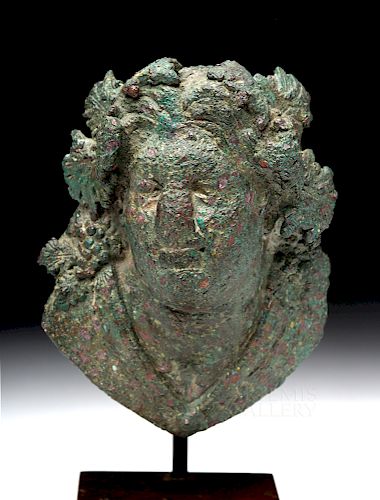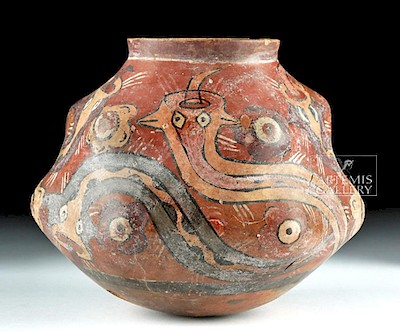Roman Bronze Applique - Bacchus / Dionysus
Lot 65
About Seller
Artemis Gallery
686 S Taylor Ave, Ste 106
Louisville, CO 80027
United States
Selling antiquities, ancient and ethnographic art online since 1993, Artemis Gallery specializes in Classical Antiquities (Egyptian, Greek, Roman, Near Eastern), Asian, Pre-Columbian, African / Tribal / Oceanographic art. Our extensive inventory includes pottery, stone, metal, wood, glass and textil...Read more
Categories
Estimate:
$3,400 - $5,100
Absentee vs Live bid
Two ways to bid:
- Leave a max absentee bid and the platform will bid on your behalf up to your maximum bid during the live auction.
- Bid live during the auction and your bids will be submitted real-time to the auctioneer.
Bid Increments
| Price | Bid Increment |
|---|---|
| $0 | $25 |
| $300 | $50 |
| $1,000 | $100 |
| $2,000 | $250 |
| $5,000 | $500 |
| $10,000 | $1,000 |
| $20,000 | $2,500 |
| $50,000 | $5,000 |
| $100,000 | $10,000 |
| $200,000 | $20,000 |
About Auction
By Artemis Gallery
Jul 5, 2018
Set Reminder
2018-07-05 10:00:00
2018-07-05 10:00:00
America/New_York
Bidsquare
Bidsquare : Ancient | Ethnographic | Fine Art
https://www.bidsquare.com/auctions/artemis-gallery/ancient-ethnographic-fine-art-3306
Featuring classical antiquities, ancient and ethnographic art from cultures encompassing the globe. Artemis Gallery info@artemisgallery.com
Featuring classical antiquities, ancient and ethnographic art from cultures encompassing the globe. Artemis Gallery info@artemisgallery.com
- Lot Description
Rome, Imperial Period, ca. 2nd century CE. A bronze applique depicting a bust of the Olympian god Bacchus (Greek Dionysos or Dionysus) - god of wine, pleasure, ritual madness, ecstasy, and theatre. The cult of Bacchus was enormously popular, signifying the freedom created by wine, music, and ecstatic dance. Romans knew the power of partying! An outstanding example with skillfully delineated facial features on his smooth face, recessed eyes, a straight nose, and full lips. He wears a leafy wreath in this long coiffure and a necklace with a round pendant. Finely cast via the lost wax (cire perdue) process. Size: 4.125" H (10.5 cm); 6.125" H (15.6 cm) on included custom stand.
Bacchanalia - also called Dionysia - were religious festivals to honor Bacchus, the god of wine, in ancient Rome. Scholars believe that they originated as the rites for fertility gods. Bacchanalia included processions, dramatic performances, and drinking feasts. The most famous of all was known as Oschophoria meaning "Carrying of the Grape Clusters". Introduced to Rome from lower Italy, Bacchanalia were initially held in secret and only attended by women for three days a year. In time, men were invited to participate, and celebrations occurred as often as five times a month. These festivals attained a reputation for orgies that led the Roman Senate to prohibit the Bacchanalia throughout Italy, with some exceptions in 186 BCE. Interestingly, a copy of the decree has survived the tests of time, in addition to an account by the Roman historian Livy. However, despite this decree, the Bacchanalia continued for years in southern Italy.
Provenance: private New York, New York, USA collection; ex prominent New York private collector
All items legal to buy/sell under U.S. Statute covering cultural patrimony Code 2600, CHAPTER 14, and are guaranteed to be as described or your money back.
A Certificate of Authenticity will accompany all winning bids.
We ship worldwide and handle all shipping in-house for your convenience.
#130841Normal surface wear with abraded areas commensurate with age. Gorgeous green patina.Condition
- Shipping Info
-
All shipping is handled in-house for your convenience. Your invoice from Artemis Gallery will include shipping calculation instructions. If in doubt, please inquire BEFORE bidding for estimated shipping costs for individual items.
-
- Buyer's Premium



 EUR
EUR CAD
CAD AUD
AUD GBP
GBP MXN
MXN HKD
HKD CNY
CNY MYR
MYR SEK
SEK SGD
SGD CHF
CHF THB
THB















